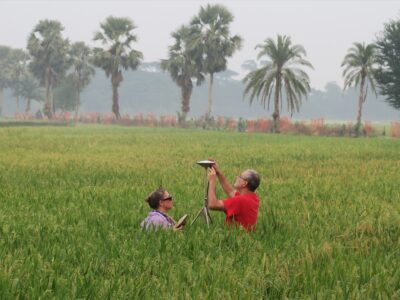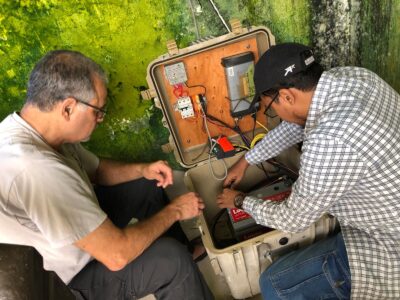Our time in Jamalganj is coming to a close. We will miss the people here, all of whom have been incredibly helpful. Moktar and Anowar, who constructed the concrete pillars; Aziz the caretaker, locally known as the chief of Jamalganj for his ability to get things done; his son, Shaheen, who will be making the weekly measurements; the iron workshop, repeated trying to get a cover design we liked; Ali, the local driller; the night watchman; Omi and the other little girls asking for their pictures to be taken; the older boys, practicing their English and playing catch with Scott N.; and all the bystanders with their interest, their suggestions, and their help. And Muktab, our Dhaka University student and translator, who will not be coming with us to the Khulna site. We will leave midday tomorrow, but take our memories and lots of pictures with us.

The GPS pillar is complete. Today they will have to build a platform so Scott N. and I can get to the top to survey in the well heights and install the GPS antenna. We also installed the receiver in the cleaned out jail cell and grounded in the walled yard.
They bought wood and built forms to construct the concrete pillars for the well. It took most of the day they weren’t ready to pour the concrete until well into the afternoon. It turned out to be a tricky task with trying to protect the fiber in the middle of the column from the concrete mixture. In the end, a leftover piece of 4” PVC pipe worked quite well. Finally the 6” diameter iron cap, competed at last, and the bridge that will hold the fiber had to be embedded in the concrete. As usual, we worked out a method on the fly, securing their position until the concrete dries with wire and bamboo.

At the deep well, we decided to pour the concrete pad before Scott D. tried to shorten the fiber. It is little bigger than the others in order to include the short piezometer well. It was drilled this morning by Ali using the hand tube well method, but the short well was finished before we got to the site. They put shortening the fiber off until the afternoon. Don’t know if that was the correct choice, as it started later than planned, took longer than planned and, of course, ended up finishing in the dark. The steel cap was connected to the protective steel tube covering the fibers and epoxied. Scott D. with Scott N. assisting took his time working on boards over still soft concrete to fusion splice the endings of the fibers with the connectors onto the cut ends from the well. The first three times failed. Even worse, one of the 125-micron fibers broke off. The duplicate pair for the well was gone. Now there was no room for mistakes. A short break, readjusting the work bench made of wooden boards and brick and try again. He did it, by the light of flashlights and headlamps before a small knot of people. A small red light was put on one fiber and a light beam came out the other. Down 765 ft to the bottom of the well and back up. The well was good.
The contrast in techniques couldn’t be more apparent. While the Scotts were splicing 125-micron glass fibers with precision instruments, twenty feet away, I was up to my elbows in concrete. For some reason they attracted the bigger crowd, except for 6-year old Omi who asked me to take pictures of a friend and herself while I was covered in cement.



